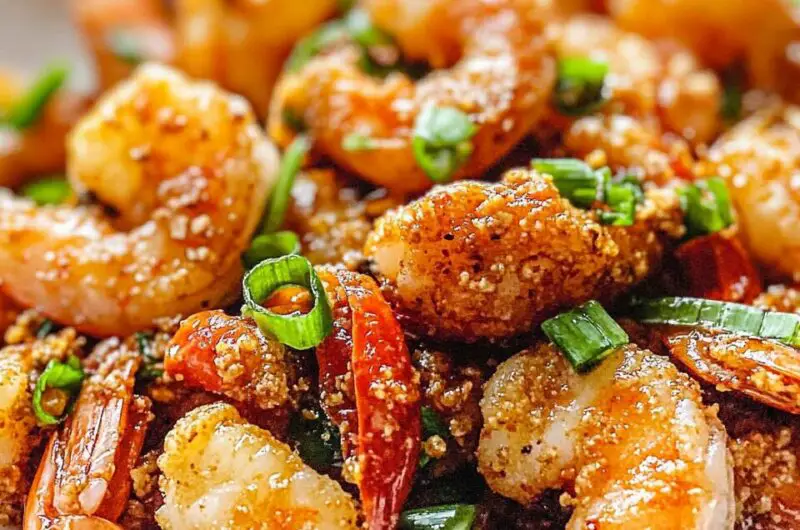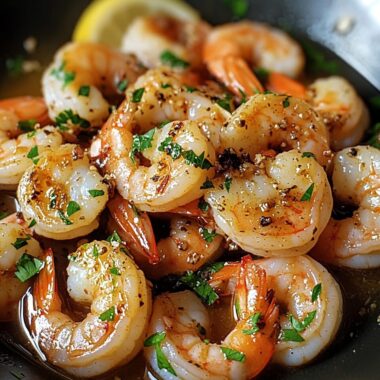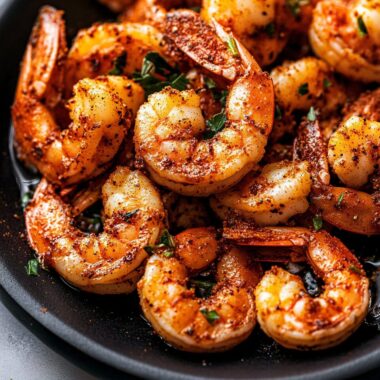The beauty of Salt and Pepper Shrimp lies in its simplicity. This popular Cantonese dish is a culinary masterpiece that requires minimal ingredients but delivers bold, unforgettable flavors. The shrimp are fried until perfectly golden and tossed with a fragrant mix of garlic, chili, and seasonings that cling to every crunchy bite. This dish is ideal for seafood lovers looking to spice things up. It’s fast enough for a weeknight meal yet fancy enough to serve guests. Leave the shells on for extra crunch and flavor, and pair with rice or eat as-is for a deliciously addictive appetizer or main course. Don’t forget the napkins you’ll be licking your fingers!
Full Recipe:
Ingredients:
-
1 lb large shrimp, shell-on, deveined
-
1 teaspoon salt
-
1 teaspoon ground white pepper
-
1/2 teaspoon black pepper
-
1/2 teaspoon sugar
-
1/2 teaspoon garlic powder
-
1/4 cup cornstarch
-
4 cloves garlic, finely minced
-
2 Thai chilies, thinly sliced
-
1 green onion, chopped
-
Vegetable oil for frying
Directions:
-
Pat the shrimp dry with paper towels. In a small bowl, mix together salt, white pepper, black pepper, sugar, and garlic powder.
-
Toss shrimp in cornstarch until fully coated.
-
Heat oil in a large skillet or wok over medium-high heat. Fry shrimp in batches for 2–3 minutes on each side until crispy and golden. Remove and drain on paper towels.
-
In a clean pan, remove excess oil, leaving about 1 tablespoon. Add minced garlic and sliced chilies. Sauté until fragrant, about 30 seconds.
-
Return the shrimp to the pan. Add the spice mixture and toss well to coat. Stir in green onions and serve immediately.
Prep Time: 10 minutes | Cooking Time: 15 minutes | Total Time: 25 minutes
Kcal: 298 kcal | Servings: 4 servings
Salt and Pepper Shrimp – A Crispy, Spicy Delight from Cantonese Cuisine
Salt and Pepper Shrimp is a beloved dish that strikes the perfect balance between simplicity and bold flavor. With a short ingredient list and quick preparation time, this crispy, aromatic seafood dish is a star in Chinese restaurants and home kitchens alike. Coated in a light crust, flash-fried to golden perfection, and tossed with fragrant garlic, chili, and pepper seasoning, this shrimp recipe is a sensory experience that satisfies every craving.
Despite its minimalist approach, Salt and Pepper Shrimp delivers maximum impact. Whether you’re hosting a dinner party, putting together a quick weeknight meal, or simply craving something crunchy, salty, and spicy, this dish ticks all the boxes.
Origins of Salt and Pepper Shrimp
This flavorful dish originates from Cantonese cuisine, one of the eight great culinary traditions of China. In Guangdong province, cooks are known for highlighting the natural taste of ingredients rather than masking them with heavy sauces. Salt and Pepper Shrimp exemplifies this philosophy shrimp is seasoned with a simple blend of salt, white pepper, and a touch of sugar, then elevated with the crunch and fragrance of garlic and hot chili peppers.
The Cantonese name for the dish is 椒盐虾 (jiāo yán xiā), which literally means “pepper salt shrimp.” It’s a variation of the classic Salt and Pepper Tofu or Salt and Pepper Squid dishes that share the same crispy, aromatic profile. Over the years, this preparation method has become a staple in Chinese takeout menus around the world and remains a home-cooking favorite among Asian families.
Why Leave the Shell On?
One of the most distinctive features of authentic Salt and Pepper Shrimp is that the shrimp is usually cooked with the shell on. While this may seem unusual to some, especially Western audiences, there are good reasons for this approach.
First, the shell locks in moisture, preventing the shrimp from drying out during the frying process. This results in a juicier, more succulent bite. Second, the shell itself becomes crispy when deep-fried, adding an extra layer of crunch that many shrimp lovers find irresistible. Finally, cooking with the shell on enhances the flavor intensity, especially when the shrimp are tossed with garlic, chili, and the pepper-salt seasoning.
If you’re not used to eating shell-on shrimp, consider giving it a try you might be surprised how satisfying it can be.
The Magic of the Seasoning
The seasoning for Salt and Pepper Shrimp is deceptively simple but incredibly effective. A blend of salt, white pepper, black pepper, sugar, and garlic powder makes up the core. The sugar balances out the saltiness and heat, while white pepper adds a distinct earthy warmth that differs from the bite of black pepper.
What makes this seasoning shine is its ability to cling to the fried shrimp without overpowering it. Unlike saucy shrimp dishes that drench the seafood in liquid, Salt and Pepper Shrimp keeps the focus on texture and aroma. The spice mix is added after frying, allowing it to adhere to the hot, crisp surface of the shrimp, mingling with the sautéed garlic, chilies, and green onions.
Cooking Techniques & Tips
Even though this dish comes together quickly, attention to detail can elevate it from good to restaurant-quality. Here are a few pro tips:
1. Dry the Shrimp Well
Before tossing the shrimp in cornstarch, make sure they are thoroughly patted dry. Excess moisture leads to soggy shrimp and oil splatter during frying.
2. Cornstarch Coating
Cornstarch is the secret to that signature light, crispy coating. It provides a crackly texture without adding heaviness, unlike flour-based batters.
3. High Heat Frying
Use a wok or a deep skillet and make sure the oil is hot enough about 350°F (175°C). Fry the shrimp in batches to avoid overcrowding, which causes the oil temperature to drop and leads to soggy shrimp.
4. Don’t Overcook
Shrimp cooks quickly. Fry each batch just until golden about 2 to 3 minutes per side. Overcooked shrimp turns rubbery and loses its natural sweetness.
5. Toss in Aromatics Last
After frying, quickly stir-fry minced garlic and chili in a small amount of oil. Toss the fried shrimp into this aromatic base along with the spice mix. This final step infuses the dish with its signature fragrance.
Variations to Explore
While the classic Salt and Pepper Shrimp is iconic, it also serves as a foundation for creativity. Here are a few ways to modify or elevate the dish:
-
Butterfly the Shrimp: Cutting the shrimp open lengthwise helps them cook faster and soak in more flavor while maintaining a juicy center.
-
Add Sichuan Peppercorns: For a numbing sensation and more complex spice profile, toss in lightly toasted Sichuan peppercorns with the garlic and chilies.
-
Use Jumbo Prawns: For a fancier presentation, use larger prawns. The crispy shell and bold flavors work beautifully with bigger cuts.
-
Air Frying or Oven-Baking: For a healthier take, skip deep frying and try using an air fryer or bake the coated shrimp on a high-temperature baking tray until crisp.
-
Vegan Version: Substitute tofu, mushrooms, or cauliflower for shrimp. The salt and pepper flavor profile pairs wonderfully with plant-based alternatives.
How to Serve Salt and Pepper Shrimp
Salt and Pepper Shrimp is a versatile dish that can be served in many ways:
-
Appetizer: Pile it high on a platter with lime wedges and dipping sauce.
-
Main Course: Serve with steamed jasmine rice or fried rice and a vegetable stir-fry.
-
Side Dish: Pair it with noodles, soup, or other Cantonese favorites like Chinese broccoli (gai lan) or egg drop soup.
-
Party Platter: Make a big batch and keep it warm in the oven Oit’s a crowd-pleaser and great finger food.
Garnish with extra chopped scallions, fresh chilies, or even cilantro for a pop of freshness and color.
Nutrition and Dietary Notes
This dish is surprisingly light in calories for how indulgent it tastes. Using shell-on shrimp and a thin cornstarch coating avoids heavy breading or batter. If you deep-fry in clean oil and serve with healthy sides like stir-fried greens or steamed vegetables, it can easily fit into a balanced meal plan.
For those watching sodium intake, reduce the salt or opt for low-sodium soy sauce as a side. If you’re sensitive to spice, remove the chili seeds or skip them altogether.
Gluten-free eaters can enjoy this dish too just ensure the cornstarch is certified gluten-free and no soy sauce is used unless it’s a gluten-free version.
Conclusion:
Salt and Pepper Shrimp is more than just a recipe it’s an experience. From the first crunchy bite to the lingering heat of chili and the warm aroma of garlic and pepper, this dish captivates your senses and leaves you wanting more. Its quick cooking time, simple prep, and explosive flavor make it a top contender for your weekly dinner rotation or your next gathering.








